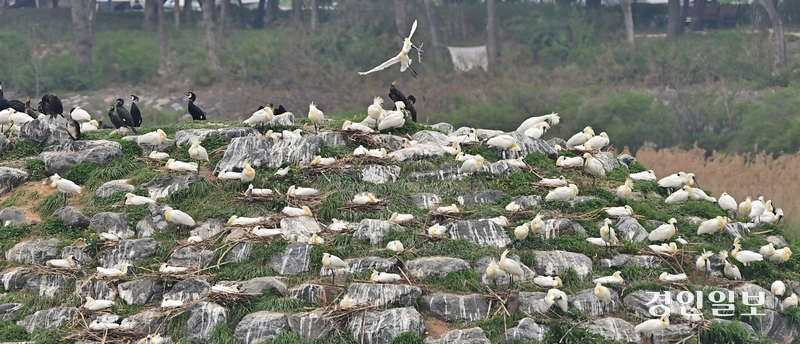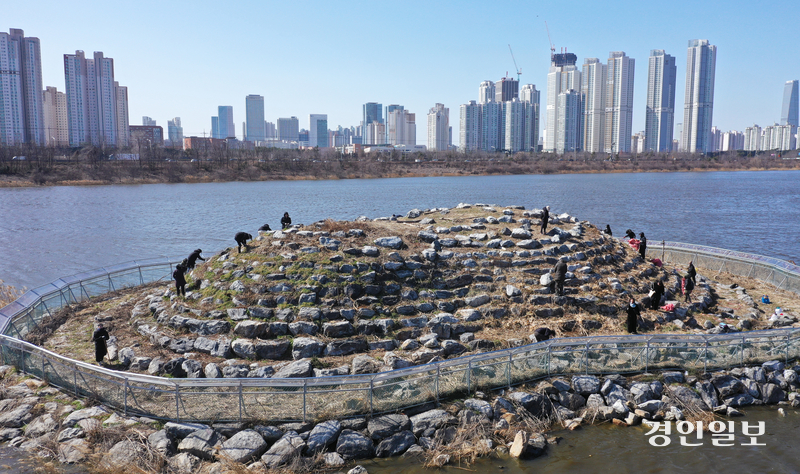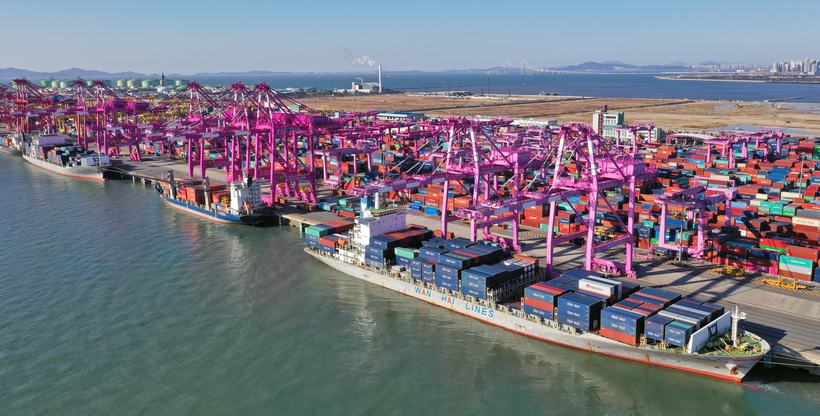저어새 멸종위기 등급 낮추려던 세계자연보전연맹
국제조류보호기구 ‘버드라이프 인터내셔널’
“새로운 정보 살펴볼 것” 경인일보 서면 인터뷰

저어새의 멸종위기 등급을 하향 조정하려던 세계자연보전연맹(IUCN)이 한국, 대만, 홍콩 등 세계 저어새 보호 활동가들의 의견을 반영해 등급 조정을 보류한 것으로 경인일보 취재를 통해 확인됐다.
16일 국제조류보호기구 ‘버드라이프 인터내셔널(BirdLife International)’ 측은 경인일보와 서면 인터뷰에서 저어새의 멸종위기 등급 조정을 보류하겠다고 밝혔다.
버드라이프 인터내셔널은 전 세계 조류 1만1천종을 조사해 멸종위기 등급에 대한 평가 의견을 세계자연보전연맹에 제출하고 있다. 세계자연보전연맹은 1948년 자연을 보호하기 위해 설립된 국제기구로 정부, NGO, 시민단체 등 1천400여개의 조직이 가입해 동식물의 멸종을 막기 위해 노력하고 있다.
버드라이프 인터내셔널에서 활동하는 이안 버필드 박사는 경인일보에 보낸 이메일에서 “저어새의 멸종위기 등급을 낮추는 것에 대해 전 세계의 저어새 전문가와 환경단체가 우려의 목소리를 전했다”며 “이들이 제시한 저어새에 대한 새로운 정보와 의견을 살펴보기 위해 저어새의 멸종위기 등급에 대한 최종 결정을 보류한다”고 했다.
최근 버드라이프 인터내셔널은 ‘위기(EN)’ 등급인 저어새의 멸종위기 등급을 두 단계 낮춘 ‘준위협(NT)’ 단계로 낮추기 위한 검토를 벌였다.(5월11일 온라인보도=“저어새 멸종위기 등급 하향은 시기상조” 인천 환경단체 목소리) IUCN은 멸종위기 동물을 멸종위험도 순서대로 절멸(EX), 야생절멸(EW), 위급(CR), 위기(EN), 취약(VU), 준위협(NT), 최소관심(LC), 정보부족(DD), 미평가(NE) 등 9개 등급으로 나누어 관리하고 있다.
버드라이프 인터내셔널은 4~6년마다 저어새를 포함한 전 세계 조류의 멸종위기 등급을 새롭게 평가한다. 저어새에 대한 평가는 2017년 이후 7년 만이다. 버드라이프 인터내셔널은 1995년 400여 마리에 불과하던 저어새가 2022년 6천여 마리로 늘어났으며 개체 수와 서식지 면적 등 IUCN의 멸종위기 등급 기준을 비추어 보았을 때 저어새가 ‘위기(EN)’ 등급에 해당하지 않아 재평가가 필요하다고 판단했다.

이러한 소식이 전해지자 저어새가 서식하는 한국, 대만, 홍콩 등 세계 조류 전문가, 환경단체 활동가 등은 저어새의 멸종위기 등급을 신중하게 조정해 달라는 의견서를 버드라이프 인터내셔널 측에 제출한 것으로 파악됐다.
전 세계에서 발송된 의견서는 64개 시민사회단체가 모인 인천갯벌세계자연유산등재추진협력단을 포함해 18개나 된다. 이들은 저어새 개체 수 증가는 전 세계 최대 서식지인 대한민국(인천 갯벌 등)을 비롯해 대만과 홍콩, 일본 등 저어새 월동지 국가, NGO, 조류 전문가 등의 인위적인 노력 덕분이며 자연 상태에선 저어새의 수가 오히려 감소할 수 있다고 주장했다.
버드라이프 인터내셔널은 이 같은 의견을 받아들여 저어새의 멸종위기 등급 조정을 보류하기로 결정했다.
인천 등 서해안 일대는 전 세계 저어새의 80% 가량이 태어나는 주요 번식지다. 매년 봄이 되면 저어새들은 인천(남동유수지 등 갯벌) 등을 찾아와 알을 낳고 겨울이 되면 월동지인 홍콩, 대만, 일본 등으로 떠난다.
우리나라 저어새 보호 활동가들은 시민과 함께 저어새가 주로 번식하는 남동유수지를 정비하고 둥지 재료를 가져다 놓는 등 저어새 개체 수를 늘리기 위해 노력하고 있다. 또 홍콩, 대만, 일본 등 현지 저어새 보호 활동가들과도 교류를 이어가고 있다. 각국 활동가들은 저어새 발목에 ‘가락지’를 부착해 가락지 색과 알파벳, 숫자로 출생 국가와 출생 시기 등을 구분하고 이동 경로를 추적하며 저어새 보호를 위해 연대하고 있다.
다음은 버드라이프 인터내셔널 이안 버필드 박사가 경인일보에 보낸 이메일 전문
Thank you for your enquiry about this species, which was passed on to us by staff at the IUCN Red List Unit. BirdLife International is the official Red List Authority for Birds, responsible for assessing and documenting the global extinction risk of all of the world’s c. 11,000 species on a regular basis, to ensure that their threat status is correctly classified on the IUCN Red List and can be used to inform the setting of conservation priorities.
IUCN requires Red List Authorities to reassess the status of relevant species at least once per decade, to ensure they remain valid. Given the rate of environmental change, BirdLife strives to reassess most bird species every 4–6 years. Black-faced Spoonbill was last assessed in 2017, when it was evaluated as Endangered due to suspected future declines. At that time, we noted that “if the predicted very rapid declines do not materialise, the species will warrant downlisting in the near future”. Seven years later, with evidence that the species’ population had continued to grow from c. 400 birds in 1995 to more than 6,000 in the non-breeding season of 2022, it was time to reassess it.
When our team of qualified Red List Assessors collated and analysed the available data, and applied all of the IUCN Red List Criteria in accordance with the IUCN Red List Guidelines, they concluded that the species no longer meets the thresholds for listing as Endangered. The IUCN Red List uses strict numeric thresholds for allocating species to different threat categories, to ensure consistency between and across taxonomic groups. Although species are reassessed frequently to ensure their IUCN Red List Category is accurate, they may move one or more categories between assessments, depending on what thresholds are met at the time of reassessment. Hence, there is no requirement for a species that was last assessed as Endangered but now qualifies as Near Threatened to spend any time in the intervening category (Vulnerable), aside from adhering to IUCN’s ‘five-year rule’ (where none of the criteria of the higher category have been met for at least five years).
BirdLife assesses species using all published and unpublished information available. However, we recognise that often information may be unpublished and/or is not readily available. Therefore, whenever a species is proposed for a category change, it is shared on a web-based forum for a planned and well-publicised period of public consultation, so that we can solicit and consider all relevant information. Hundreds of species have been consulted on in this way, over many years.
Over the past few weeks, this protocol has been followed for Black-faced Spoonbill, and the forum has attracted 18 comments from species experts and other stakeholders in countries spanning most of its breeding and non-breeding range. We have therefore heard from and listened to a wide range of contributors interested in this proposal, many of whom have provided useful information that was previously either unpublished or otherwise unavailable to us.
As sometimes happens in these situations, we have therefore decided to pend the final decision for Black-faced Spoonbill, to allow more time to fully consider and evaluate all the new information that has come to light through the consultation. Until this process is complete and a new assessment is published as part of the IUCN Red List, the current assessment continues to apply. Therefore, the status of the species remains Endangered at present.
We trust that this response answers your questions and provides you with the information you sought. Thank you for your interest in the Red List process.
Yours sincerely Dr Ian Burfield
Global Science Coordinator (Species)
Bird Red List Authority Coordinator
Benjamin Olewine Fellow












